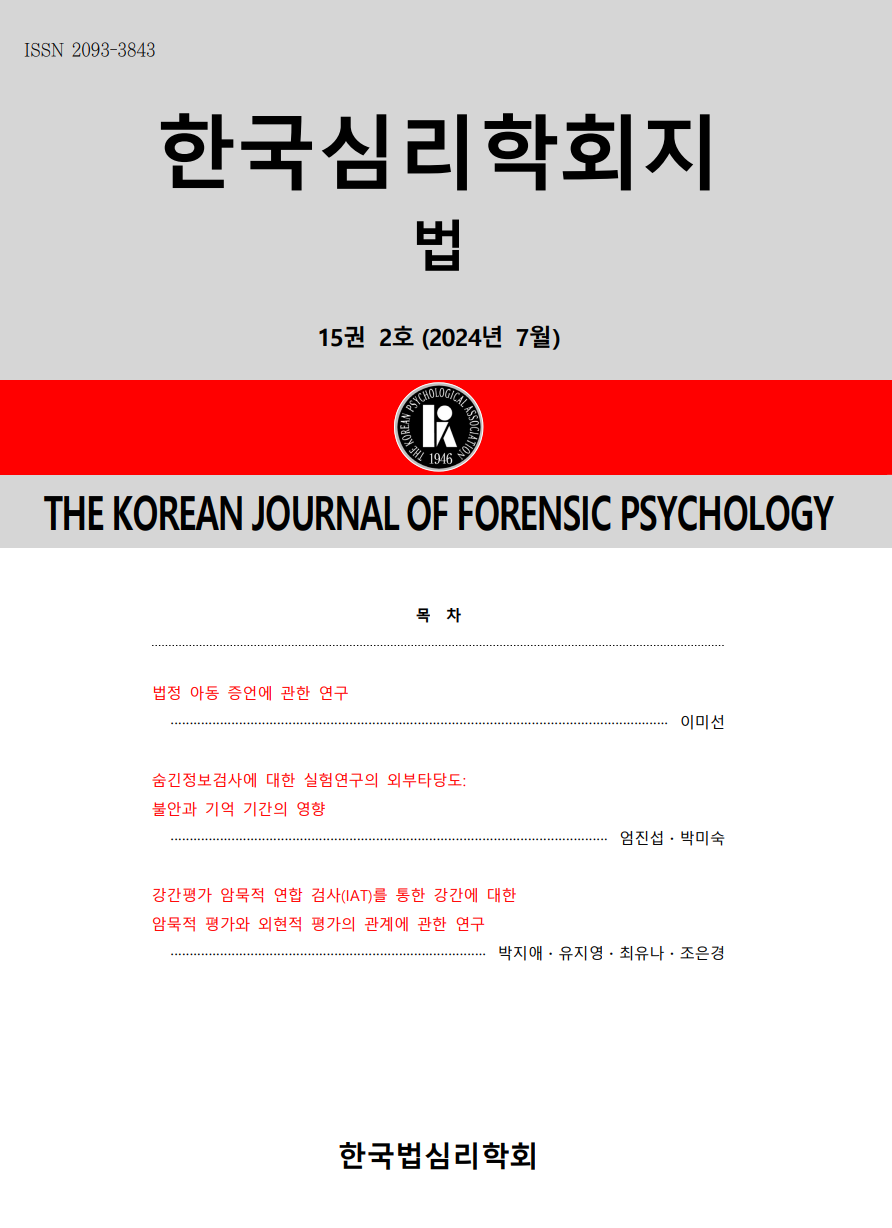open access
메뉴
open access
메뉴 ISSN : 2093-3843
ISSN : 2093-3843
The purpose of this study is to examine the influences of physical environment features such as residential setting on the commitment of criminal behavior. In experimental 1, subjects evaluated the perceived criminal allowance within their actual residences and were asked to judge a criminal behavior in a given dilemma situation. The result shows that their judgments positive correlation with the criminal allowance. In experimental 2, residential environment was primed using 4 photographs each condition(well organized / badly organized environment). Subjects were asked to imagine that they lived in the areas in the photos. They decided to what extend the offenses can be allowed to live in the area surrounded with well organized environment, judged that their criminal behavior could be more accepted than those who in the area surrounded with disordered and badly organized one. And males tended to accept their crime more than females. The limitations of the study and suggestions for the further research were discussed.
김범준 (2007). 강간범죄에 대한 위험도 인식과 가치판단에 관한 연구: 남녀차이. 한국심리학회지: 사회 및 성격, 21(3). 57-73.
김영제 (2007). CPTED와 범죄통제 거버넌스가범죄두려움에 미치는 영향. 연세대학교 박사학위청구논문.
김지선 (2008). 환경적 특성이 범죄에 미치는 영향에 관한 연구: 인천시 연수구의 1 인 가구를 중심으로. 경기대학교 석사학위청구논문.
김창윤 (2009). 한국의 지역적 범죄특성에 관한 연구: 울산광역시 10 년간 범죄발생분석을 중심으로. 사회과학연구, 15(1), 103-123.
김형중 (2012). 알코올과 범죄와의 상관성에관한 연구: 음주범죄에 대한 허용성과 관용적 인식을 중심으로. 한국시민윤리학회보, 25(2), 1-30.
류전철 (2012). 범죄피해자의 관점에서 탄핵증거의 허용범위에 관한 소고. 피해자학 연구, 20(2), 121-141.
박명규 (2003). GIS의 공간분석을 활용한 범죄예측지도의 구현: 서울시 성북구를 사례로. 경희대학교 석사 학위 청구논문.
박태진 (2001). 암묵적 및 명시적 심리과정 -연구와 응용: 기억의 암묵적 인출과 외현적 인출에 관한 선택적 개관. 한국심리학회 추계 심포지움 자료집, 17-36.
배금예, 김영환 (1997). 불안과 우울이 암묵기억과 외현기억에 미치는 영향. 한국심리학회지: 임상, 16(2), 119-132.
법무부 (2015). 범죄백서. 법무연수원.
이진환, 홍기원 역 (2004). 환경심리학. 서울:시그마프레스.
조은경 (1997). 범죄에 대한 두려움에 영향을미치는 요인들. 한국심리학회지: 사회 및성격, 11(2), 29-51.
조은경 (2003). 범죄에 대한 두려움에 있어서남성과 여성의 차이. 한국심리학회지: 사회문제, 9(1), 1-21.
최인섭, 김지선 (1995). 전과자에 대한 사회적인식에 관한 연구. 한국형사정책연구원
현주하, 엄기민, 한광희 (2008). 사회적 거리와정서가 도덕 판단에 미치는 영향. 감성과학, 12(4), 411-424.
Adam B. M., Brian A. C., and Michael J. K.. (2008). Who shalt not kill?: Individual differences in working memory capacity, executive control, and moral judgment. Psychological Science, 19(6), 549-557.
Brantingham, P. L., & Brantingham, P. J. (1990). Environmental criminology. Beverly Hills, CA:Sage Publication.
Caughy, M., O’Campo, P., & Muntaner, C.(2003). When being alone might be better:Neighborhood poverty, social capital, and child mental health. Social Science & Medicine, 57, 227-237.
Ekman, P. (1993). Facial expression and emotion. American Psychologist, 48, 384-392.
Farrall, S., Bannister, J., Ditton, J. and Gilchrist, E. (2000). Social psychology and the fear of crime: Re-examining a speculative model, British Journal of Criminology 40, 399-413.
Ferraro, K. F. (1995). Crime: Interpreting victimization. Albany: State University of New York Press.
Garofalo, J. (1979). Victimization and the fear of crime. Journal of Research in Crime and Delinquency, 16, 80-97.
Graf, P., & Schacter, D. L. (1985). Implicit and explicit memory for new associations in normal and amnesic subjects. Journal of Experimental Psychology: Learning, Memory, and Cognition, 11(3), 501-518.
Herbert, D. T. (1985). Environmental criminology:Testing some area. Transaction, Institute of British Geographers, 10, 259-274.
Higgins, E. T., Rholes, W. S., & Jones, C. R. (1977). Category accessibility and impression formation. Journal of Experimental Social Psychology, 13, 141-154.
Hunter, A. (1978). Symbols of incivility: Social disorder and fear of crime in urban neighborhoods. Paper presented at Annual Meeting of the American. Society of Criminology. Dallas, Texas, November.
Keltener, D., & Shiota, M. N. (2003). New displays and new emotion: A commentary on Rozin and Cohen. Emotion, 3, 86-91.
Lewis, D. A., & Maxfield, M. G. (1980). Fear in the neighborhoods: An investigation of the impact of crime. Journal of Research in Crime and Delinquency, 16, 160-189.
Nagin, D. S., & Paternoster, R. (1993). Enduring individual differences and rational choice theories of crime. Law & Society Review, 27, 467-496.
Newman, O. (1972). Defensible spaces: People &design in the violent city. New York: Macmillan.
Pezzin, L. E. (1995). Earning prospects, matching effects, and the decision to terminate a criminal career. Journal of Quantitative Criminology, 11, 29-50.
Pinter, R. O., & Astor, R. A. (2008). Children’s reasoning about poverty, physical deterioration, danger, and retribution in neighborhood contexts. Journal of Environmental Psychology. 28, 327-338.
Reber, S. (1985). The penguin dictionary of psychology. New York: Penguin.
Taylor, R. (1997). Social order and disorder of street blocks and neighborhoods: Ecology, microecology and the systemic model of social disorganization. Journal of Research in Crime and Delinquency, 33, 113-155
Tulving, E., & Schacter, D. L. (1990). Priming and human memory systems. Science, 247, 301-305.
Wilson, J. Q., & Kelling, G. L. (1982). Broken window. The Atlantic Monthly. (http://www.heatlantic.com/magazine/archive/1982/03/broken-windows/304465/).
Zimbardo, P. G. (1969). The human choice:individuation, reason and order versus deindividuation, impulse and chaos. W. J. Armold and D. Levine (Eds.). In Nebraska symposium on motivation. Lincoln: University of Nebraska Press.